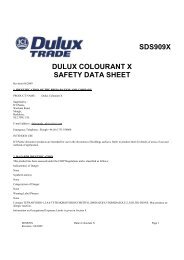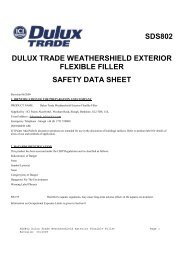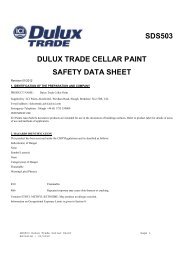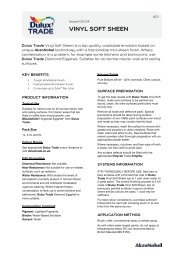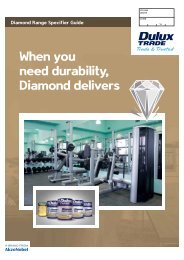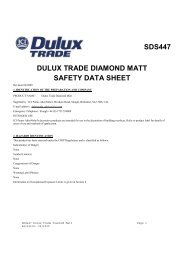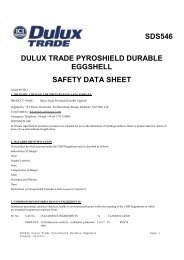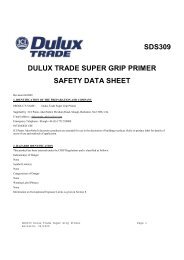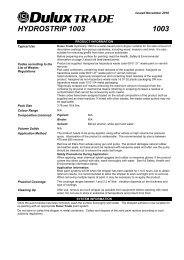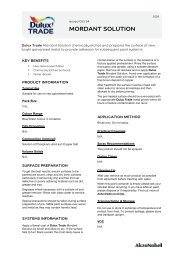Download PDF safety datasheet SDS616 for Dulux Trade Diamond ...
Download PDF safety datasheet SDS616 for Dulux Trade Diamond ...
Download PDF safety datasheet SDS616 for Dulux Trade Diamond ...
- No tags were found...
You also want an ePaper? Increase the reach of your titles
YUMPU automatically turns print PDFs into web optimized ePapers that Google loves.
7. HANDLING AND STORAGEHANDLING CONDITIONS: Prevent air-borne concentrations higher than the occupational exposure limits. Keep the container tightly closed.Exclude sources of heat, sparks and open flame. Avoid skin and eye contact. Avoid inhalation of vapour. Smoking, eating and drinking should beprohibited in storage and use areas. For personal protection, see Section 8. Always keep in containers made of the same material as the supplycontainer, or in containers that are compatible with the product.STORAGE CONDITIONS: Observe the label precautions. Store in a cool, dry, well ventilated place away from sources of heat, ignition anddirect sunlight. No smoking. Prevent unauthorised access. Containers which are opened should be properly resealed and kept upright to preventleakage. Do not use or store any paint container by hanging on a hook.The Manual Handling Operations Regulations 1993 may apply to the handling of certain Paint Products. Products packed in containers of 5 litresand above will be marked with a guide weight; refer to these weights when carrying out an assessment.The principles contained in the HSE guidance note Storage of Packaged Dangerous Substances, should be observed when storing this product.Store separately from oxidising agents, strongly alkaline and strongly acidic materials, amines, alcohols and water.SPECIFIC USE(s): Where applicable refer to the product label and literature <strong>for</strong> the application and use instructions.8. EXPOSURE CONTROLS/PERSONAL PROTECTIONEXPOSURE LIMIT VALUESHAZARDOUS INGREDIENTLTEL (8hrTWA) ppmLTEL (8hrTWA) mg/m3STEL (15mins) ppmSTEL (15mins) mg/m3NotesNO SUBSTANCES REQUIRED TO BE LISTED IN THIS SECTIONOEL - Occupational Exposure LimitsWEL - Workplace Exposure LimitSUP - Manufacturer's recommended LimitLTEL - Long-term Exposure Limit.TWA - Time weighted AverageSTEL - Short term Exposure Limit (15mins)sk - Risk of absorption through unbroken skinsen - Respiratory sensitiserrd - Figure quoted is <strong>for</strong> Respirable dustid - Figure quoted is <strong>for</strong> Inhalable dustFurther guidance on WELs and OELs, and on occupational exposure to harmful materials (including mixed exposures) is givenin HSE Guidance Note EH40.EXPOSURE CONTROLSBe<strong>for</strong>e commencing work, ensure that a COSHH Assessment has been carried out. All personal protective equipment, includingrespiratory protective equipment, used to control exposure to hazardous substances must be selected to meet the requirements oflocal regulations.RESPIRATORY PROTECTION: Avoid the inhalation of vapour, particulates and spray mist. Where reasonably practicable, thisshould be achieved by the use of local exhaust ventilation and good general ventilation. If this is not sufficient to maintainconcentrations of particulates and solvent vapour below the occupational exposure limit, respiratory protection must be worn.The selection of respiratory equipment should be in accordance with BS529:2005. Recommendations <strong>for</strong> the selection, use andmaintenance of Respiratory Equipment, and the current certificates of approval are issued annually by the Health and SafetyExecutive.For solvent-based products, consider using water-based products as alternatives, where equivalent products exist. Work only inplaces of good ventilation. Inside always keep doors and windows fully open during application and drying. When applyingsolvent-based products by brush or roller to large surface areas inside, or using in small confined spaces, the wearing of airsupplied breathing apparatus will be necessary except that when applying <strong>for</strong> short periods only, a cartridge mask may be wornproviding the filter is changed regularly. Do not spray any product unless directed to do so on the container. The principalhazards associated with paint spraying are health hazard from inhalation of vapours and spray mist, and fire risk. When applyingwater-based paints by spray inside or in confined spaces, wearing a cartridge mask of Assigned Protection Factor 40 x OEL <strong>for</strong>particulates is recommended. This should be confirmed by your COSHH assessment. Contact your merchant about masks. Whenapplying solvent-based paints by spray, in case of insufficient ventilation, the wearing of air-fed respiratory equipment willalways be necessary. Refer to your COSHH assessment. When spraying solvent based products it is possible to build up anexplosive or flammable atmosphere: refer to Guidance Note EH9 from the HSE or advice on good practice. All respiratoryequipment must be suitable <strong>for</strong> the purpose and meet an appropriate standard approved by the HSE. Refer to BS529:2005HAND PROTECTION: Wear suitable gloves <strong>for</strong> protection against materials in section 3.<strong>SDS616</strong> <strong>Dulux</strong> <strong>Trade</strong> <strong>Diamond</strong> Glaze Page 3Revision: 10/2011




